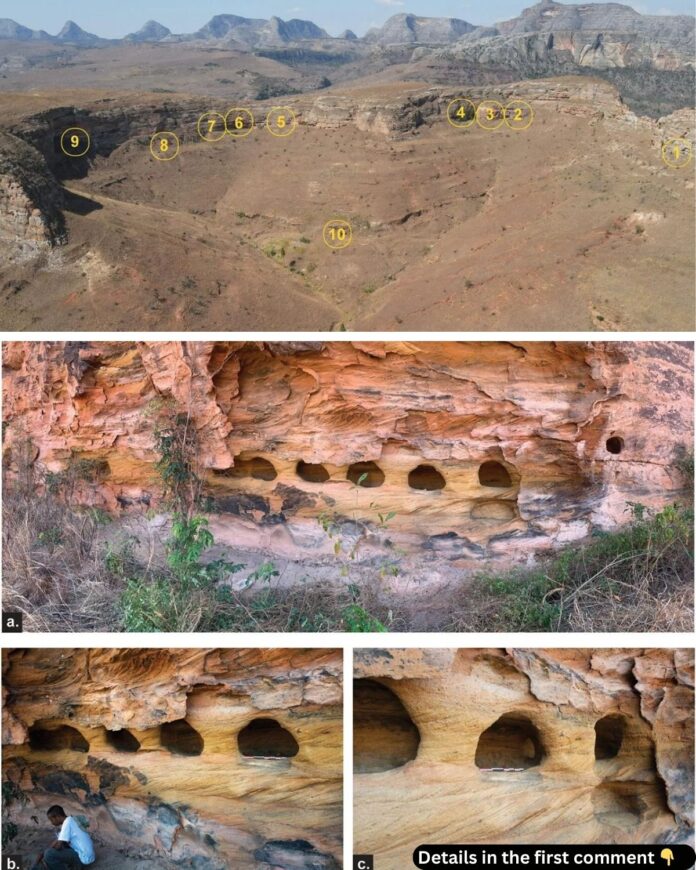In the remote Isalo Massif of southern Madagascar lies a discovery that has challenged long-held notions of the island’s history. The site, known as Teniky, features an extraordinary rock-cut architectural complex with no parallels in East Africa or the surrounding regions. Archaeologists have proposed a groundbreaking hypothesis: this enigmatic site may trace its origins to ancient Zoroastrian settlers, revealing Madagascar’s role as a crossroads of culture, trade, and migration in the medieval world.
The Discovery at Teniky
Teniky is nestled within the rugged terrain of Madagascar’s Isalo Massif, a striking location that adds to the mystery of its purpose and origins. The site boasts an array of unique features: circular niches carved into rock faces, artificial terraces, and intricately constructed stone basins. Using radiocarbon dating on charcoal found during excavations, researchers have pinpointed the construction of these structures to between the 10th and 12th centuries CE.
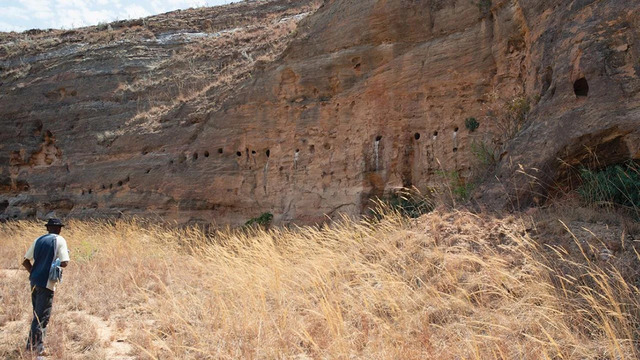
What makes this discovery even more fascinating is its inland location, over 200 kilometers from Madagascar’s nearest coast. Despite this distance, the site offers compelling evidence of its connection to the vast Indian Ocean trade network, with artifacts such as imported ceramics from China and Southeast Asia discovered in its vicinity. This suggests that Teniky was more than an isolated settlement; it was part of a thriving global exchange of goods and ideas.
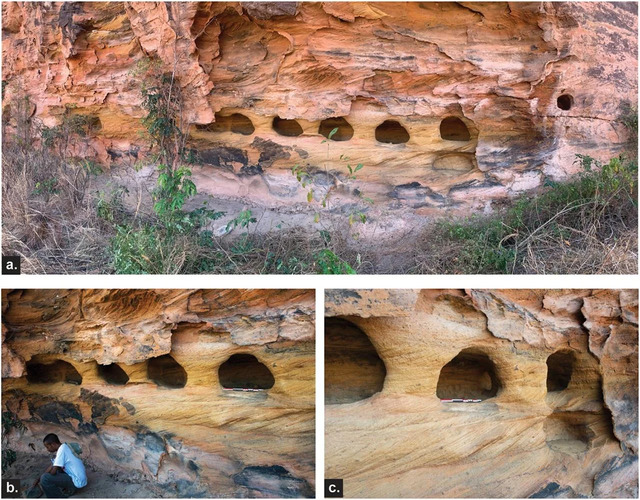
Video
Explore Madagascar’s enigmatic rock-cut architecture, which suggests Zoroastrian origins – watch the video to uncover the mysteries behind this ancient and fascinating site!
Trade Networks and Cultural Connections
The discovery of Chinese and Southeast Asian ceramics at Teniky highlights Madagascar’s integration into the medieval Indian Ocean trade network. During this period, the Indian Ocean was a bustling maritime highway, linking distant civilizations from Africa to Southeast Asia. Despite its inland location, Teniky’s role in this trade network underscores its importance as a cultural and economic hub.
The site’s inland position raises intriguing questions about its purpose. Was it a resting point for traders venturing deep into Madagascar’s interior, or perhaps a retreat for a specific community? The connection to such a wide network suggests that Teniky was not only strategically located but also culturally significant, providing a bridge between Madagascar and the larger world.
Architectural Parallels to Zoroastrian Traditions
Perhaps the most striking aspect of Teniky is the architectural similarity between its niches and those found in Iran’s Fars region, a heartland of ancient Zoroastrianism. These rock-cut niches in Iran were often associated with funerary practices, leading archaeologists to speculate that Teniky may have served as a necropolis for Zoroastrian settlers.
Zoroastrianism, one of the world’s oldest religions, places a strong emphasis on the duality of life and death, as well as the purity of elements like earth and fire. The architectural features at Teniky suggest an intentional design aligned with these principles. The niches may have been used for ritual purposes or as part of a funerary practice unique to the settlers who arrived in Madagascar.
While no direct evidence, such as Zoroastrian artifacts, has yet been uncovered, the stylistic parallels between Teniky and Iranian sites offer a tantalizing possibility. If confirmed, this would not only rewrite Madagascar’s history but also reveal a previously unknown chapter of Zoroastrian migration and influence.
Ruling Out Previous Theories
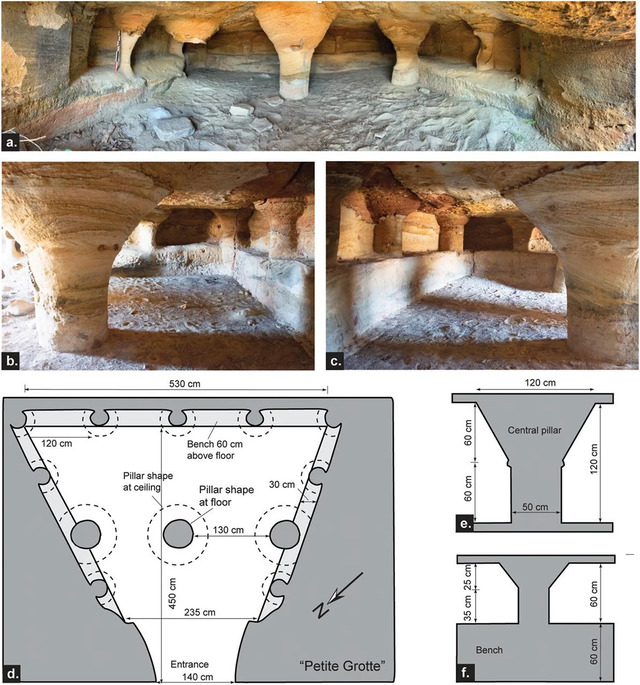
Before the current hypothesis emerged, some researchers suggested that the Teniky structures were built by shipwrecked Portuguese sailors in the 16th century. However, this theory has been debunked, as Portuguese ships did not enter the Indian Ocean until 1498, and there is no evidence linking them to the site. Additionally, the radiocarbon dating of Teniky’s structures predates the arrival of the Portuguese by several centuries.
This elimination of European influence strengthens the case for an earlier, non-European origin. It also shifts focus toward understanding the indigenous and external forces that shaped Madagascar’s history during the medieval period.
Migration, Beliefs, and Adaptation
If the hypothesis of Zoroastrian settlers is correct, several questions arise. How did these settlers arrive in Madagascar? Historical records suggest that Zoroastrian communities were active in trade across the Indian Ocean, and Madagascar could have been a natural extension of their reach.
Once they arrived, did their beliefs and practices remain intact, or did they evolve in response to interactions with local populations? It is possible that the Teniky settlers blended their traditions with those of Madagascar’s indigenous communities, creating a unique cultural synthesis. Alternatively, they may have maintained a distinct identity, as evidenced by the architectural parallels to Iranian sites.
Another mystery is the eventual abandonment of Teniky. Was it due to changes in trade routes, resource scarcity, or cultural assimilation? Understanding why the site was deserted may provide further insight into the challenges faced by Madagascar’s early inhabitants.
Genetic and Archaeological Evidence
Madagascar’s present-day population reflects a rich tapestry of African and Asian ancestry, a testament to centuries of migration and cultural exchange. Genetic studies have highlighted this diversity, but the archaeological record has been sparse. The discovery of Teniky adds a crucial piece to the puzzle, suggesting that Madagascar’s settlement was far more complex and multicultural than previously thought.
The presence of Zoroastrian settlers, if confirmed, would provide a new dimension to this narrative, highlighting the island’s role as a melting pot of cultures connected by the Indian Ocean.
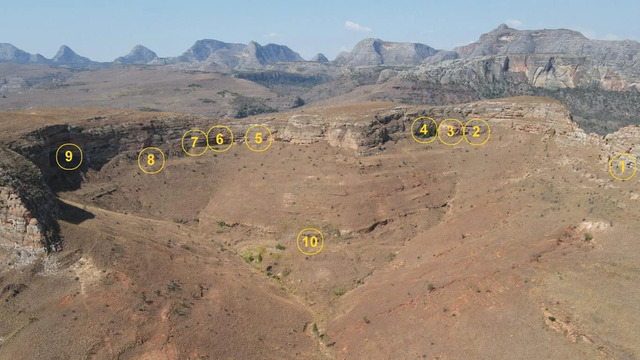
Challenges in Preservation
Despite its historical significance, the Teniky site has faced threats from looting and environmental degradation. Although it is located within Isalo National Park, additional measures are needed to protect and preserve this cultural treasure. Researchers have called for increased funding and international collaboration to ensure that Teniky remains a source of knowledge for future generations.
The importance of preserving Teniky goes beyond its architectural features. It represents a tangible link to Madagascar’s past and a reminder of the island’s connections to the broader world.
Implications of the Discovery
The discovery at Teniky has profound implications for our understanding of Madagascar’s history. It challenges the notion of the island as an isolated entity and positions it as a critical node in the medieval Indian Ocean world. The site’s architectural features and artifacts point to a rich cultural exchange, suggesting that Madagascar was not only a recipient of external influences but also an active participant in shaping regional history.
Teniky’s potential Zoroastrian origins also underscore the importance of interdisciplinary research in archaeology. By combining radiocarbon dating, stylistic analysis, and historical context, researchers are uncovering new layers of Madagascar’s past that were previously hidden.
Conclusion
Teniky’s enigmatic rock-cut architecture offers a glimpse into Madagascar’s multicultural history, blending local traditions with possible influences from distant Zoroastrian communities. This discovery not only enriches our understanding of the island’s past but also highlights the importance of preserving its heritage. As researchers continue to study Teniky, we may uncover even more about the migration, trade, and cultural exchange that shaped Madagascar’s unique identity. In doing so, we honor the legacy of a site that connects us to a shared human history, one that transcends borders and time.
